Ryobi WS730 User Manual
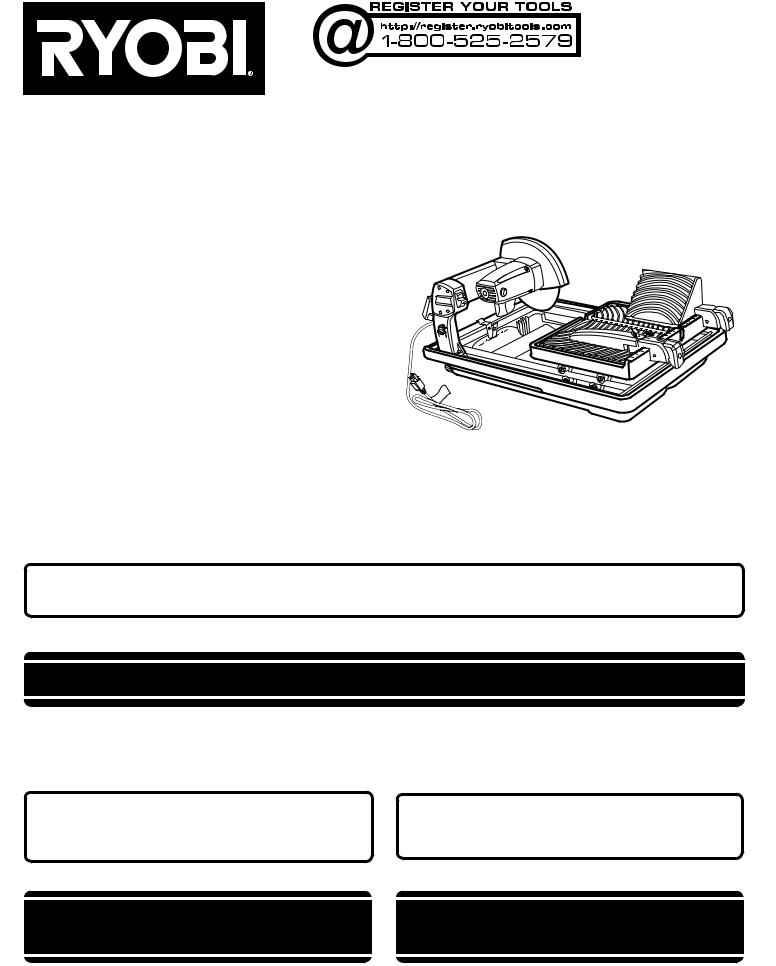
OPERATOR’S MANUAL
MANUEL D’UTILISATION MANUAL DEL OPERADOR
7 in. Tile SAW
SCIE À carreaux DE 178 mm (7 po)
SIERRA DE losas DE 178 mm (7 pulg.)
WS730
Your saw has been engineered and manufactured to our high standard for dependability, ease of operation, and operator safety. When properly cared for, it will give you years of rugged, trouble-free performance.
 WARNING: To reduce the risk of injury, the user must read and understand the operator’s manual before using this product.
WARNING: To reduce the risk of injury, the user must read and understand the operator’s manual before using this product.
Thank you for your purchase.
SAVE THIS MANUAL FOR FUTURE REFERENCE
Cette scie a été conçue et fabriquée conformément aux strictes normes de fiabilité, simplicité d’emploi et sécurité
d’utilisation. Correctement entretenu, cet outil vous donnera des années de fonctionnement robuste et sans problème.
 AVERTISSEMENT : Pour réduire les risques de blessures, l’utilisateur doit lire et veiller à bien comprendre le manuel d’utilisation avant d’employer ce produit.
AVERTISSEMENT : Pour réduire les risques de blessures, l’utilisateur doit lire et veiller à bien comprendre le manuel d’utilisation avant d’employer ce produit.
Merci de votre achat.
Su sierra ha sido diseñado y fabricado de conformidad con nuestras estrictas normas para brindar fiabilidad, facilidad de uso y seguridad para el operador. Con el debido cuidado, le brindará muchos años de sólido funcionamiento y sin problemas.
 ADVERTENCIA: Para reducir el riesgo de lesiones, el usuario debe leer y comprender el manual del operador antes de usar este producto.
ADVERTENCIA: Para reducir el riesgo de lesiones, el usuario debe leer y comprender el manual del operador antes de usar este producto.
Le agradecemos su compra.
CONSERVER CE MANUEL POUR |
GUARDE ESTE MANUAL PARA |
FUTURE RÉFÉRENCE |
FUTURAS CONSULTAS |

|
TABLE OF CONTENTS |
Introduction...................................................................................................................................................................... |
2 |
Warranty........................................................................................................................................................................... |
2 |
General Safety Rules..................................................................................................................................................... |
3-4 |
Specific Safety Rules....................................................................................................................................................... |
5 |
Symbols........................................................................................................................................................................ |
6-7 |
Electrical........................................................................................................................................................................ |
8-9 |
Features...................................................................................................................................................................... |
9-10 |
Assembly................................................................................................................................................................... |
10-12 |
Operation.................................................................................................................................................................. |
12-14 |
Adjustments................................................................................................................................................................... |
15 |
Maintenance.............................................................................................................................................................. |
15-16 |
Accessories.................................................................................................................................................................... |
16 |
Figure numbers (illlustrations)................................................................................................................................... |
17-20 |
Parts Ordering / Service.................................................................................................................................... |
Back page |
|
INTRODUCTION |
This product has many features for making its use more pleasant and enjoyable. Safety, performance, and dependability have been given top priority in the design of this product making it easy to maintain and operate.
warranty
RYOBI® POWER TOOL - LIMITED TWO YEAR WARRANTY AND 30 DAY EXCHANGE POLICY
One World Technologies, Inc., warrants its RYOBI® power tools with the following conditions:
30-DAY EXCHANGE POLICY: During the first 30 days after date of purchase, you may either request service under this warranty or you may exchange any RYOBI® power tool which does not work properly due to defective workmanship or materials by returning the power tool to the dealer from which it was purchased. To receive a replacement power tool or requested warranty service, you must present proof of purchase and return all original equipment packaged with the original product. The replacement power tool will be covered by the limited warranty for the balance of the two year period from the date of the original purchase.
WHAT THIS WARRANTY COVERS: This warranty covers all defects in workmanship or materials in your RYOBI® power tool for a period of two years from the date of purchase. With the exception of batteries, power tool accessories are warranted for ninety (90) days. Batteries are warranted for two years.
HOW TO GET SERVICE: Just return the power tool, properly packaged and postage prepaid, to an Authorized Service Center. You can obtain the location of the Service Center nearest you by contacting a service representative at One World Technologies, Inc., P.O. Box 1207, Anderson, SC 29622-1207, by calling 1-800-525-2579 or by logging on to www. ryobitools.com. When you request warranty service, you must also present proof of purchase documentation, which includes the date of purchase (for example, a bill of sale). We will repair any faulty workmanship, and either repair or replace any defective part, at our option. We will do so without any charge to you. We will complete the work in a reasonable time, but, in any case, within ninety (90) days or less.
WHAT’S NOT COVERED: This warranty applies only to the original purchaser at retail and may not be transferred. This warranty only covers defects arising under normal usage and does not cover any malfunction, failure or defects resulting from misuse, abuse, neglect, alteration, modification or repairs by other than Authorized Service Centers. One World Technologies, Inc. makes no warranties, representations or promises as to the quality or performance of its power tools other than those specifically stated in this warranty.
ADDITIONAL LIMITATIONS: Any implied warranties granted under state law, including warranties of merchantability or fitness for a particular purpose, are limited to two years from the date of purchase. One World Technologies, Inc. is not responsible for direct, indirect, or incidental damages, so the above limitations and exclusions may not apply to you. This warranty gives you specific legal rights, and you may also have other rights which vary from state to state.
2

GENERAL SAFETY RULES
WARNING:
Read and understand all instructions. Failure to follow all instructions listed below, may result in electric shock, fire and/or serious personal injury.
READ ALL INSTRUCTIONS
KNOW YOUR POWER TOOL. Read the operator’s manual carefully. Learn the saw’s applications and limitations as well as the specific potential hazards related to this tool.
GUARDAGAINSTELECTRICALSHOCKbypreventing body contact with grounded surfaces.
For example, pipes, radiators, ranges, refrigerator enclosures.
KEEP GUARDS IN PLACE and in good working order.
REMOVE ADJUSTING KEYS AND WRENCHES. Form habit of checking to see that keys and adjusting wrenches are removed from tool before turning it on.
KEEPWORKAREACLEAN.Clutteredareasandbenches invite accidents. DO NOT leave tools or pieces of wood on the saw while it is in operation.
DO NOT USE IN DANGEROUS ENVIRONMENTS. Do not use power tools in damp or wet locations or expose to rain. Keep the work area well lit.
KEEP CHILDREN AND VISITORS AWAY. All visitors should wear safety glasses and be kept a safe distance from work area. Do not let visitors contact tool or extension cord while operating.
MAKE WORKSHOP CHILDPROOF with padlocks and master switches, or by removing starter keys.
DON’T FORCE TOOL. It will do the job better and safer at the feed rate for which it was designed.
USE RIGHT TOOL. Don’t force the tool or attachment to do a job it was not designed for. Don’t use it for a purpose not intended.
USE THE PROPER Extension Cord. Make sure your extension cord is in good condition. Use only a cord heavy enough to carry the current your product will draw. An undersized cord will cause a drop in line voltage resulting in loss of power and overheating. A wire gauge size (A.W.G.) of at least 14 is recommended for an extension cord 25 feet or less in length. If in doubt, use the next heavier gauge. The smaller the gauge number, the heavier the cord.
DRESS PROPERLY. Do not wear loose clothing, gloves, neckties, or jewelry. They can get caught and draw you into moving parts. Rubber gloves and nonskid footwear (rubber soled boots) are recommended when working outdoors. Also wear protective hair covering to contain long hair.
ALWAYS WEAR SAFETY GLASSES WITH SIDE SHIELDS. Everyday eyeglasses have only impactresistant lenses, they are not safety glasses.
SECURE WORK. Use clamps or a vise to hold work when practical, it is safer than using your hand and frees both hands to operate the tool.
DON’T OVERREACH. Keep proper footing and balance at all times.
MAINTAIN TOOLS WITH CARE. Keep tools sharp and clean for better and safer performance. Follow instructions for lubricating and changing accessories.
DISCONNECT TOOLS. When not in use, before servicing, or when changing attachments, blades, bits, cutters, etc., all tools should be disconnected.
AVOID ACCIDENTAL STARTING. Be sure switch is off when plugging in any tool.
USE RECOMMENDED ACCESSORIES. Consult the operator’s manual for recommended accessories. The use of improper accessories may risk injury.
NEVER STAND ON TOOL. Serious injury could occur if the tool is tipped or if the cutting tool is unintentionally contacted.
CHECK DAMAGED PARTS. Before further use of the tool, a guard or other part that is damaged should be carefully checked to determine that it will operate properly and perform its intended function. Check for alignment of moving parts, binding of moving parts, breakage of parts, mounting and any other conditions that may affect its operation. A guard or other part that is damaged must be properly repaired or replaced by an authorized service center to avoid risk of personal injury.
USE THE RIGHT DIRECTION OF FEED. Feed work into a blade or cutter against the direction of rotation of blade or cutter only.
NEVER LEAVE TOOL RUNNING UNATTENDED. TURN THE POWER OFF. Don’t leave tool until it comes to a complete stop.
PROTECT YOUR LUNGS. Wear a face or dust mask if the cutting operation is dusty.
PROTECT YOUR HEARING. Wear hearing protection during extended periods of operation.
DO NOT ABUSE CORD. Never yank cord to disconnect from receptacle. Keep cord away from heat, oil, and sharp edges.
ALWAYS use an outdoor extension cord marked “W-A” or “W”. These cords are rated for outdoor use and reduce the risk of electric shock.
ALWAYS KEEP THE WHEEL GUARD IN PLACE and in working order.
3 — English

GENERAL SAFETY RULES
KEEP HANDS AWAY FROM CUTTING AREA. Keep hands away from wheels. Do not reach underneath work or around or over the wheel while wheel is rotating. Do not attempt to remove cut material when wheel is moving.
WHEEL coasts after being turned off.
NEVER USE IN AN EXPLOSIVE ATMOSPHERE.
Normal sparking of the motor could ignite fumes.
Inspect TOOL CORDS periodically. If damaged, have repaired by a qualified service technician at anauthorizedservicefacility.Theconductorwithinsulation having an outer surface that is green with or without yellow stripes is the equipment-grounding conductor. If repair or replacement of the electric cord or plug is necessary, do not connect the equipment-grounding conductor to a live terminal. Repair or replace a damaged or worn cord immediately. Stay constantly aware of cord location and keep it well away from the rotating blade.
Inspect EXTENSION CORDS periodically and replace if damaged.
GROUND ALL TOOLS. If tool is equipped with threeprong plug, it should be plugged into a three-hole electrical receptacle.
CHECK WITH A QUALIFIED ELECTRICIAN or service personnel if the grounding instructions are not completely understood or if in doubt as to whether the tool is properly grounded.
Use only correct electrical devices: 3-wire extension cords that have 3-prong grounding plugs and 3-pole receptacles that accept the tool's plug.
DO NOT MODIFY the plug provided. If it will not fit the outlet, have the proper outlet installed by a qualified electrician.
Keep TOOL dry, clean, and free from oil and grease. Always use a clean cloth when cleaning. Never
use brake fluids, gasoline, petroleum-based products, or any solvents to clean tool.
STAY ALERT AND EXERCISE CONTROL. Watch what you are doing and use common sense. Do not operate tool when you are tired. Do not rush.
DO NOT USE TOOL IF SWITCH DOES NOT TURN IT ON AND OFF. Have defective switches replaced by an authorized service center.
USE ONLY CORRECT WHEELs. Do not use wheels with incorrect size holes. Never use washers or arbor nuts that are defective or incorrect. The maximum wheel capacity of your saw is 7 in. (178 mm).
Before making a cut, be sure all adjustments are secure.
Never touch WHEEL or other moving parts during use.
NEVER START A TOOL WHEN ANY ROTATiNG COMPONENT IS IN CONTACT WITH THE WORKPIECE.
DO NOT operate A tool while under the influence of drugs, alcohol, or any medication.
When servicing use only identical replacement parts. Use of any other parts may create a hazard or cause product damage.
Use only recommended accessories listed in this manual or addendums. Use of accessories that are not listed may cause the risk of personal injury. Instructions for safe use of accessories are included with the accessory.
DOUBLE CHECK ALL SETUPS. Make sure blade is tight and not making contact with saw or workpiece before connecting to power supply.
4 — English

SPECIFIC SAFETY RULES
ALWAYS SECURE work firmly against the rip guide or bevel block.
NEVER stand or have any part of your body in line with the path of the wheel.
NEVER attempt to free a stalled wheel without first turning the saw OFF and disconnecting the saw from the power source.
IF THE POWER SUPPLY CORD IS DAMAGED, it must be replaced only by the manufacturer or by an authorized service center to avoid risk.
AVOID AWKWARD OPERATIONS AND HAND POSITIONS where a sudden slip could cause your hand to move into the cutting tool.
make sure the work area has ample lighting to see the work and that no obstructions will interfere with safe operation BEFORE performing any work using the saw.
ALWAYS TURN OFF SAW before disconnecting it, to avoid accidental starting when reconnecting to power supply.
THIS TOOL should have the following markings:
a)Wear eye protection.
b)Use splash guard for every operation for which it can be used.
c)Disconnect saw before servicing, when changing cutting wheels, and cleaning.
d)Use tool only with smooth edge cutting wheels free of openings, grooves, and teeth.
e)Replace damaged cutting wheel before operating.
f)Do not fill water bath above water fill line.
SAVE THESE INSTRUCTIONS. Refer to them frequently and use to instruct other users. If you loan someone this tool, loan them these instructions too.
5 — English
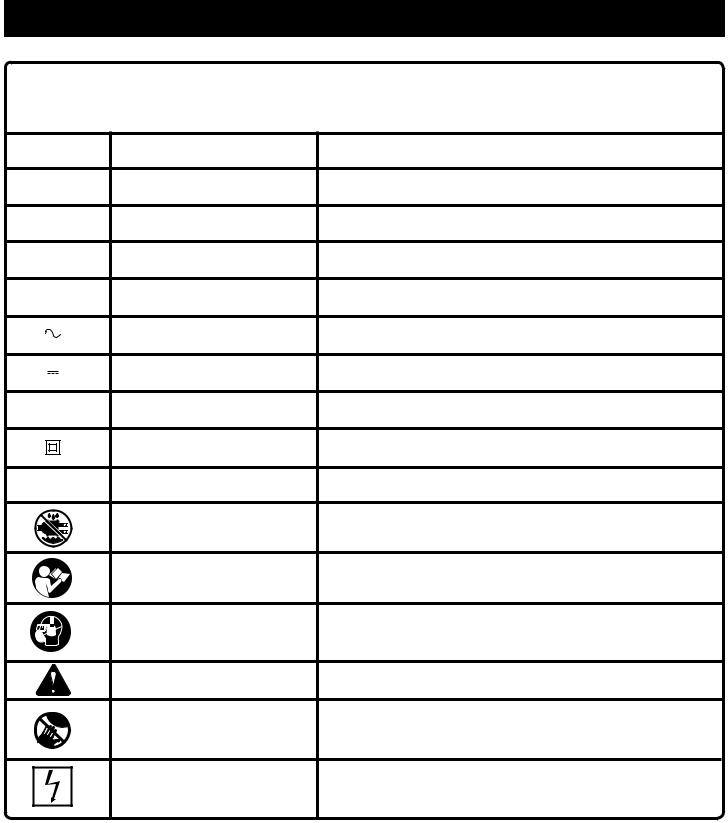
SYMBOLS
Some of the following symbols may be used on this tool. Please study them and learn their meaning. Proper interpretation of these symbols will allow you to operate the tool better and safer.
SYMBOL |
NAME |
DESIGNATION/EXPLANATION |
V |
Volts |
Voltage |
A |
Amperes |
Current |
Hz |
Hertz |
Frequency (cycles per second) |
W |
Watt |
Power |
min |
Minutes |
Time |
|
Alternating Current |
Type of current |
|
Direct Current |
Type or a characteristic of current |
no |
No Load Speed |
Rotational speed, at no load |
|
Class II Construction |
Double-insulated construction |
.../min |
Per Minute |
Revolutions, strokes, surface speed, orbits etc., per minute |
|
Wet Conditions Alert |
Do not expose to rain or use in damp locations. |
|
Read The Operator’s Manual |
To reduce the risk of injury, user must read and understand |
|
operator’s manual before using this product. |
|
|
|
|
|
Eye, Ear, & Breathing |
Wear eye, hearing, and breathing protection when operating this |
|
Protection |
equipment. |
|
Safety Alert |
Precautions that involve your safety. |
|
No Hands Symbol |
Failure to keep your hands away from the blade will result in |
|
serious personal injury. |
|
|
|
|
|
Electrocution |
Failure to properly ground can result in electrocution. |
6 — English
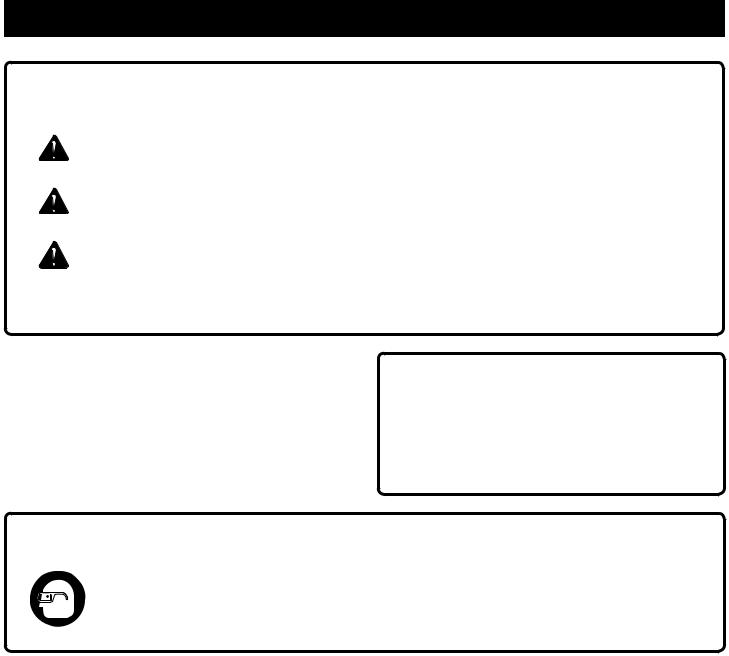
SYMBOLS
The following signal words and meanings are intended to explain the levels of risk associated with this product.
SYMBOL |
SIGNAL |
MEANING |
|
|
|
|
DANGER: |
Indicates an imminently hazardous situation, which, if not avoided, will result |
|
in death or serious injury. |
|
|
|
|
|
|
|
|
WARNING: |
Indicates a potentially hazardous situation, which, if not avoided, could result |
|
in death or serious injury. |
|
|
|
|
|
|
|
|
CAUTION: |
Indicates a potentially hazardous situation, which, if not avoided, may result in |
|
minor or moderate injury. |
|
|
|
|
|
|
|
|
CAUTION: |
(Without Safety Alert Symbol) Indicates a situation that may result in property |
|
damage. |
|
|
|
SERVICE
Servicing requires extreme care and knowledge and should be performed only by a qualified service technician. For service we suggest you return the product to your nearest
AUTHORIZED SERVICE CENTER for repair. When servicing, use only identical replacement parts.
 WARNING:
WARNING:
To avoid serious personal injury, do not attempt to use this product until you read thoroughly and understand completely the operator’s manual. If you do not understand the warnings and instructions in the operator’s manual, do not use this product. Call Ryobi customer service for assistance.
 WARNING:
WARNING:
The operation of any power tool can result in foreign objects being thrown into your eyes, which can result in severe eye damage. Before beginning power tool operation, always wear safety goggles or safety glasses with side shields and, when needed, a full face shield. We recommend Wide Vision Safety Mask for use over eyeglasses or standard safety glasses with side shields. Always use eye protection which is marked to comply with ANSI Z87.1.
SAVE THESE INSTRUCTIONS
7 — English
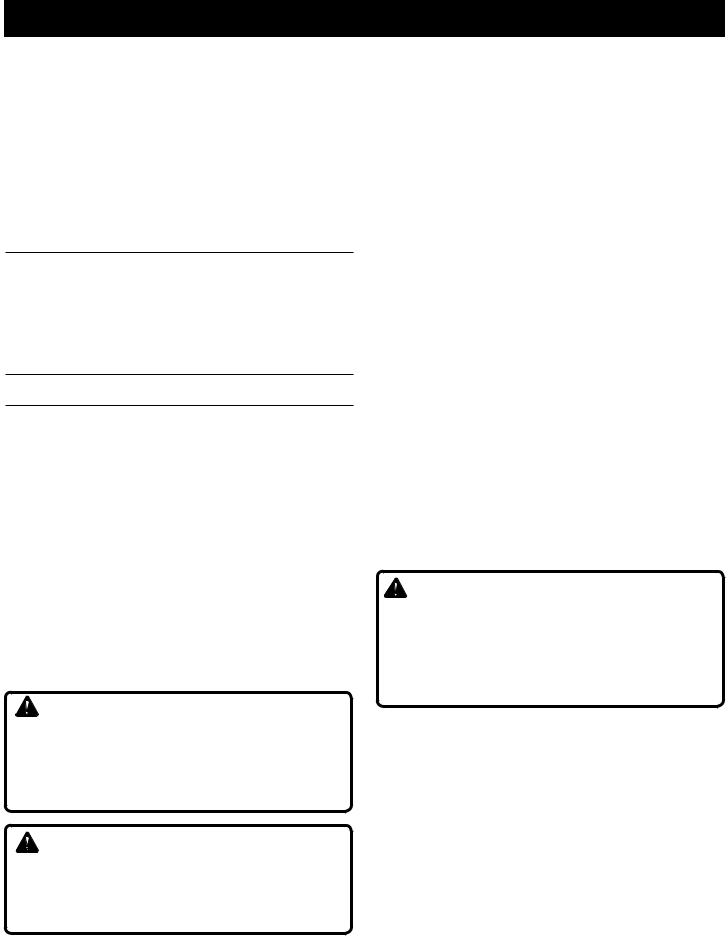
ELECTRICAL
Extension Cords
Use only 3-wire extension cords that have 3-prong grounding plugs and 3-pole receptacles that accept the tool’s plug. When using a power tool at a considerable distance from the power source, use an extension cord heavy enough to carry the current that the tool will draw. An undersized extension cord will cause a drop in line voltage, resulting in a loss of power and causing the motor to overheat. Use the chart provided below to determine the minimum wire size required in an extension cord. Only round jacketed cords listed by Underwriter’s Laboratories (UL) should be used.
**Ampere rating (on tool data plate) |
|
|
|
|
||
|
0-2.0 |
2.1-3.4 |
3.5-5.0 5.1-7.0 |
7.1-12.0 |
12.1-16.0 |
|
|
|
|
|
|||
Cord Length |
Wire Size (A.W.G.) |
|
|
|||
|
|
|
|
|
|
|
25' |
16 |
16 |
16 |
16 |
14 |
14 |
50' |
16 |
16 |
16 |
14 |
14 |
12 |
|
|
|
|
|
|
|
100' |
16 |
16 |
14 |
12 |
10 |
— |
**Used on 12 gauge - 20 amp circuit. NOTE: AWG = American Wire Gauge
Always use an extension cord that is designed for outside use. This is indicated by the letters “W-A” or “W” on the cord’s jacket.
Before using an extension cord, inspect it for loose or exposed wires and cut or worn insulation.
Use only extension cords that are intended for outdoor use. These extension cords are identified by a marking “Acceptable for use with outdoor appliances; store indoors while not in use”. Use only extension cords having an electrical rating not less than the rating of the product. Do not use damaged extension cords. Examine extension cord before using and replace if damaged. Do not abuse extension cords and do not yank on any cord to disconnect. Keep cord away from heat and sharp edges. Always disconnect the extension cord from the receptacle before disconnecting the product from the extension cord.
WARNING:
Keep the extension cord clear of the working area. Position the cord so that it will not get caught on lumber, tools or other obstructions while you are working with a power tool. Failure to do so can result in serious personal injury.
WARNING:
Check extension cords before each use. If damaged replace immediately. Never use tool with a damaged cord since touching the damaged area could cause electrical shock resulting in serious injury.
Electrical Connection
This tool is powered by a precision built electric motor. It should be connected to a power supply that is 120 V, AC only (normal household current), 60 Hz. Do not operate this tool on direct current (DC). A substantial voltage drop will cause a loss of power and the motor will overheat. If the saw does not operate when plugged into an outlet, double check the power supply.
SPEED AND WIRING
The no-load speed of this tool is approximately 5,800 rpm. This speed is not constant and decreases under a load or with lower voltage. For voltage, the wiring in a shop is as important as the motor’s horsepower rating. A line intended only for lights cannot properly carry a power tool motor. Wire that is heavy enough for a short distance will be too light for a greater distance. A line that can support one power tool may not be able to support two or three tools.
Grounding Instructions
See Figure 1, page 17.
This product must be grounded. In the event of a malfunction or breakdown, grounding provides a path of least resistance for electric current to reduce the risk of electric shock. This tool is equipped with an electric cord having an equipmentgrounding conductor and a grounding plug. The plug must be plugged into a matching outlet that is properly installed and grounded in accordance with all local codes and ordinances.
Do not modify the plug provided. If it will not fit the outlet, have the proper outlet installed by a qualified electrician.
WARNING:
Improper installation of the grounding plug is able to result in a risk of electric shock. When repair or replacement of the cord is required, do not connect the grounding wire to either flat blade terminal. The wire with insulation having an outer surface that is green with or without yellow stripes is the grounding wire.
Check with a qualified electrician or service personnel if the grounding instructions are not completely understood, or if in doubt as to whether the tool is properly grounded.
Repair or replace a damaged or worn cord immediately.
This product is for use on a nominal 120 volt circuit and has a grounding plug similar to the plug illustrated in figure 1, page 17. Only connect the product to an outlet having the same configuration as the plug. Do not use an adapter with this product.
Ground Fault Circuit Interrupter (GFCI) protection should be provided on the circuit(s) or outlet(s) to be used for the tile saw. Outlets are available having built-in GFCI protection and may be used for this measure of safety.
8 — English

ELECTRICAL
If the saw is used with an extension cord, ensure the connection of the tool’s power cord and the extension cord are not on the ground.
If a protected outlet is not available, do not use the saw until an outlet can be changed or auxiliary protection can be obtained. These auxiliary protection devices are available at your local retailer.
below the level of the outlet, or the connector if an extension cord is used, to prevent water traveling along the cord and coming in contact with the outlet.
If the plug or outlet does get wet, DO NOT unplug the cord. Disconnect the fuse or circuit breaker that supplies power to the tool then unplug and examine for the presence of water in the outlet.
POSITION OF THE TILE saw
See Figure 2, page 17.
To avoid the possibility of the tool plug or outlet getting wet, position tile saw to one side of a wall-mounted outlet to prevent water from dripping onto the outlet or plug. The operator should arrange a “drip loop” in the cord connecting the saw to the outlet. The “drip loop” is that part of the cord
WARNING:
To reduce the risk of electrocution, keep all connections dry and off the ground. Do not touch the plug with wet hands.
FEATURES
PRODUCT SPECIFICATIONS
Blade Diameter............................................................. |
7 in. |
Blade Arbor............................................................... |
5/8 in. |
Throat Capacity...................................................... |
9-1/2 in. |
Rip Capacity (tile size)................................................. |
16 in. |
KNOW YOUR tILE saw
See Figure 3, page 18.
The safe use of this product requires an understanding of the information on the tool and in this operator’s manual as well as a knowledge of the project you are attempting. Before use of this product, familiarize yourself with all operating features and safety rules.
7 in. Tile CUTTING wheel - A 7 in. tile cutting wheel is included with your saw.
WARNING:
Do not use wheels rated less than the speed of this tool. Failure to heed this warning could result in personal injury.
BEVEL BLOCK - Bevel block supports tile for fast, clean, and consistent 45º edges.
NOTE: Only use bevel block on the right-hand side of the table.
Diagonal Capacity (tile size) |
........................................12 in. |
Maximum Depth of Cut.......................................... |
2 - 1/4 in. |
Rating.............................................. |
120 V~, 60 Hz, 9 Amps |
No Load Speed...................................... |
5,800 r/min. (RPM) |
CLEAN WAVE WALL™ - If you purchased the optional pump, the Clean Wave Wall™ system helps prevent sediment from entering the pump to extend pump life.
NOTE: Optional pump sold separately.
easy glide table™ - For precise and accurate cuts.
END-OF-CUT REMINDER - End cut reminder prevents chips and broken tiles by slowing down the Easy Glide Table at the end of a cut. Also acts as hose holder.
FLOW ADJUSTMENT VALVE - Turns water flow to the cutting wheel either on or off. When used with the optional water pump, this feature becomes a variable flow adjustment.
MOTOR - This machine has a strong motor with sufficient power to handle tough cutting jobs. It also has externally accessible brushes for ease of servicing.
ON/OFF SWITCH - This saw has an easy access power switch located below the front rail. To lock the switch in the OFF position, remove the switch key from the switch. Place the key in a location that is inaccessible to children and others not qualified to use the tool.
9 — English
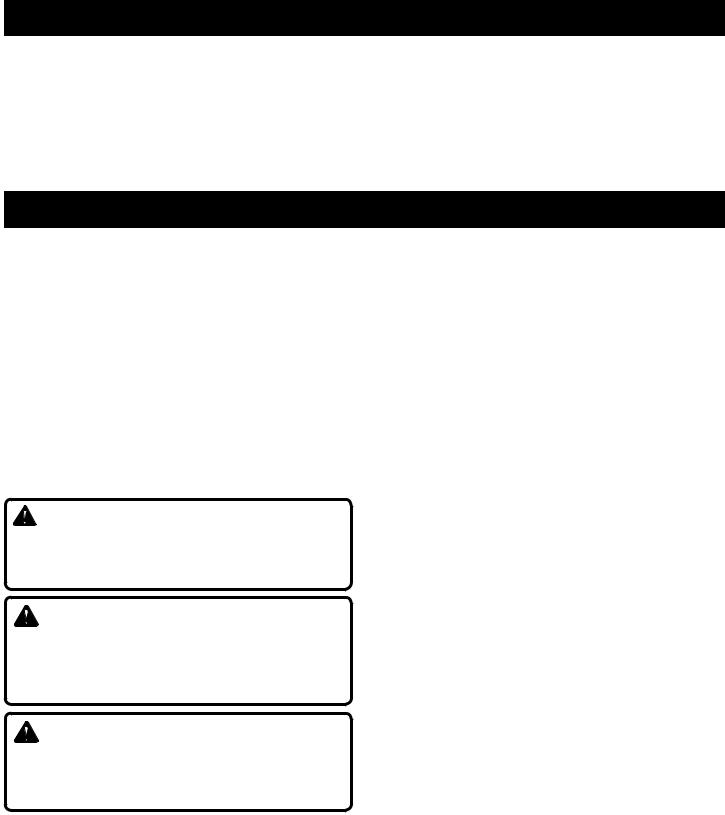
FEATURES
PUMPLESS FLOW SYSTEM™ - The pumpless flow system sprays clean, fresh water on blade for trouble-free cutting. This fully enclosed water system keeps internal cords and hoses dry and securely out of the way.
RIP GUIDE - Rip guide is fully adjustable for straight and miter cuts.
SPLASH GUARD - The splash guard provides protection from overspray and mist.
UPPER WHEEL GUARD - Protects user from wheel contact on upper portion of wheel.
ASSEMBLY
UNPACKING
This product requires assembly.
Carefully lift the saw from the carton and place on a level work surface.
Inspect the tool carefully to make sure no breakage or damage occurred during shipping.
Do not discard the packing material until you have carefully inspected and satisfactorily operated the tool.
The saw is factory set for accurate cutting. After assembling it, check for accuracy. If shipping has influenced the settings, refer to specific procedures explained in this manual.
If any parts are damaged or missing, please call 1-800-525-2579 for assistance.
Warning:
If any parts are damaged or missing do not operate this tool until the parts are replaced. Failure to heed this warning could result in serious personal injury.
warning:
Do not attempt to modify this tool or create accessories not recommended for use with this tool. Any such alteration or modification is misuse and could result in a hazardous condition leading to possible serious personal injury.
WARNING:
Do not connect to power supply until assembly is complete. Failure to comply could result in accidental start-
ing and possible serious personal injury.
Installing motor head ASSEMBLY to frame
See Figure 6, page 19.
Align the holes in the motor head assembly with the holes on the side of the water tray frame.
Insert large and small socket head screws and finger tighten.
Using the hex key, securely tighten the large socket head screws on the side of the water tray frame.
Tighten the small socket head screws last.
Installing eND-of-cUT rEMINDER
See Figure 7, page 19.
The end-of-cut reminder has two purposes: 1) to keep the garden hose secure and out of the way, and, 2) to slow down the Easy Glide Table™ to help prevent tile from cracking and chipping.
Align the hole in the end-of-cut reminder with the hole in the inside of the back of the water tray frame.
Using a screw, secure the end-of-cut reminder in place.
Installing spLASH GUARD
See Figure 8, page 20.
Align the hole in the splash guard with the hole in the back of the motor head assembly.
Using the flat washer and screw, secure the splash guard in place.
Installing WATER supply VALVE to THE water tray
See Figure 9, page 20.
Unscrew the water supply valve cap.
Place the water supply valve into the hole in the water tray as shown in figure 9.
Screw the water supply valve cap onto the threaded end of the valve and tighten securely.
Installing Tile Saw to THE water tray
See Figure 9, page 20.
Carefully place the water tray frame inside the water tray.
Saw head assembly goes to the back of the frame where the hose connections are located.
10 — English

ASSEMBLY
Installing clear hose to water connection
See Figure 10, page 20.
Attach the clear hose into the water supply valve connection on the inside of the water tray.
tile cutting wheel
For maximum performance and safety, it is recommended that you use the 7 in. cutting wheel provided with your saw. Additional cutting wheels of the same high quality are
available at your local dealer.
 WARNING:
WARNING:
Do not use cutting wheels rated less than the no load speed of this tool. Failure to heed this warning could result in personal injury. Do not use wheel with cracks, gaps, or teeth.
 WARNING:
WARNING:
To prevent possible electrical hazards, have a qualified electrician check the line if you are not certain that it is properly wired.
Installing TILE CUTTING WHEEL
See Figures 11 - 13, page 20.
WARNING:
A 7 in. tile cutting wheel is the maximum wheel capacity of the saw. Never use a wheel that is too thick to allow wheel washer to engage with the flats on the spindle. Larger wheels will come in contact with the wheel guard, while thicker wheels will prevent the wheel bolt from securing the wheel on the spindle. Either of these situations could result in a serious accident and can cause serious personal injury.
Unplug the saw.
Loosen the wheel guard lock.
Rotate wheel guard back to expose the arbor nut.
Fit the wheel wrench on the arbor nut then the hex key in the spindle.
Holding the hex key in place to prevent the wheel from moving, turn the arbor nut counterclockwise. Remove the hex key, wheel wrench, arbor nut and outer washer.
Do not remove the inner washer.
Wipe a drop of oil onto inner washer where it contacts the wheel.
WARNING:
If inner washer has been removed, replace it before placing wheel on spindle. Failure to do so could cause an accident since the wheel will not tighten properly. Never use wheels that have openings, grooves, or teeth on this tool.
Place the cutting wheel onto spindle.
Replace outer blade washer. The double “D” flats on the blade washers align with the flats on the spindle.
Using hex key and wheel wrench, tighten arbor nut securely.
Retighten the wheel guard lock securely.
Installing the rip guide
See Figure 14, page 21.
Place the rip guide in the unlocked position (lever up).
Fit the rip guide onto the permanent fence on the Easy Glide Table™.
Lock the rip guide in place by pushing the lever down.
Installing the bevel block
See Figure 15, page 21.
Place the bevel block in the unlocked position (lever up).
Fit the bevel block tab into the slot and onto the permanent fence on the sliding table.
Lock the bevel block in place by pushing the lever down.
NOTE: The bevel block should only be used on the right side of the Easy Glide Table™.
connecting garden hose to the tile saw
See Figure 16, page 21.
The water supply must come from a fresh water main. NEVER turn the water supply on high.
Uncoil the garden hose.
With the water main faucet turned completely off, attach the end of the garden hose to the water supply valve. Tighten by hand.
Secure hose to the water tray as shown.
The water supply valve provides a convenient on/off for starting, stopping, and adjusting the water flow onto the wheel. When used properly, the water supply valve adjusts the water flow to the perfect, optimal rate.
11 — English

ASSEMBLY
connecting the drainage hose
See Figure 17, page 21.
Always place the drainage hose into a small barrel or bucket so debris can drain from water tray.
Unscrew the cap from the drainage output.
Attach a drainage hose to the drainage output and place other end of the hose into a bucket or barrel.
Do not overflow the bucket or spill water on the ground near the machine.
Discard waste water in accordance with local regulations.
OPERATION
WARNING:
Do not allow familiarity with tools to make you careless. Remember that a careless fraction of a second is sufficient to inflict serious injury.
NOTE: When on/off switch is turned off, immediately turn off the flow adjustment valve.
To lock your saw:
With the saw turned OFF, pull the switch key from the switch and store in a safe, secure location.
WARNING:
Always wear safety goggles or safety glasses with side shields when operating power tools. Failure to do so could result in objects being thrown into your eyes resulting in possible serious injury.
 WARNING:
WARNING:
In the event of a power failure or when the tool is not in use, turn the switch OFF and remove the switch key. This action will prevent the tool from accidentally starting when power returns.
WARNING:
Do not use any attachments or accessories not recommended by the manufacturer of this tool. The use of attachments or accessories not recommended can result in serious personal injury.
APPLICATIONS
You may use this tool for the purposes listed below:
Straight line cutting operations such as cross cutting, mitering, ripping, and beveling
NOTE: This saw is designed to cut man-made tile, pavers, and stone tile products only.
on/off SWITCH
See Figure 18, page 21.
Your saw is equipped with an on/off switch that has a built-in locking feature. This feature is intended to prevent unauthorized and possible hazardous use by children and others.
TO TURN YOUR SAW ON:
With the switch key inserted into the switch, lift the switch button to turn ON.
NOTE: When on/off switch is turned on, immediately turn on the flow adjustment valve.
TO TURN YOUR SAW OFF:
Press the switch button down to turn OFF.
 WARNING:
WARNING:
ALWAYS make sure your workpiece is not in contact with the cutting wheel before operating the switch to start the tool. Failure to heed this warning may cause the workpiece to be kicked back toward the operator and result in serious personal injury.
 Warning:
Warning:
To reduce the risk of accidental starting, Always make sure the switch is in the OFF position before plugging tool into the power source.
using the rip guide
See Figure 19, page 22.
The rip guide can be used from both the left and right side of the cutting wheel.
Place the rip guide in the desired position.
Push the lever down to lock in place.
To adjust angles:
Loosen the lock knob.
Set to the desired angle by moving the lower part of the rip guide left or right.
Tighten the knob securely before turning on the saw.
12 — English

OPERATION
using THE WATER supply valve
See Figure 20, page 22.
The water supply valve allows you to adjust the water flowing onto the wheel.
using THE FLOW ADJUSTMENT VALVE
See Figure 21, page 22.
When using the pumpless flow system, this valve must be turned on and off immediately following turning the saw on or off.
When using the optional pump (not included), the flow adjustment valve can be used to adjust the flow of water.
MAKING CUTS
Always draw the line to be cut on the tile using a marker or grease pencil. If the tile is shiny and hard-to-mark, place masking tape on the tile and mark the tape.
A common problem when cutting tile is straying from the marked line. Once you’ve strayed from the mark, you can not force the wheel back to the line by twisting the tile. Instead, back up and recut the tile slicing off a small amount of tile until the wheel is back on track.
To avoid this problem, use the bevel block or rip guide whenever possible. Use the rip guide when making cross cuts and miter cuts and the bevel block for bevel cuts.
To make a cross cut
See Figure 22, page 22.
Cross cuts are straight 90° cuts. The material is fed into the cut at a 90° angle to the wheel, and the wheel is vertical.
Using a marker or grease pencil, mark the area to be cut on material.
Set the rip guide to 0°, tighten the lock knob, and lock in place.
Place the material on the table and firmly against the rip guide and fence.
Make sure the material is clear of the cutting wheel before turning on the saw.
Turn the on/off switch to the on position.
Turn the flow adjustment valve to the on position.
Let the cutting wheel build up to full speed and wait for the wheel to get wet before moving the material into the wheel.
Hold the material firmly against the rip guide and feed the material into the cutting wheel.
When the cut is made, turn the saw OFF. Wait for the cutting wheel to come to a complete stop before removing any part of the material.
To make a diagonal cut
See Figure 23, page 22.
Diagonal cuts are also referred to as “long point to long point cuts”.
Using a marker or grease pencil, mark the area to be cut on material.
Set the rip guide to the desired angle, lock in place, and tighten the lock knob.
Place the material on the table and firmly against the rip guide and fence.
Make sure the material is clear of the cutting wheel before turning on the saw.
Turn the on/off switch to the on position.
Turn the flow adjustment valve to the on position.
Let the cutting wheel build up to full speed and wait for the wheel to get wet before moving the material into the wheel.
Hold the material firmly against the rip guide and feed the material into the cutting wheel.
When the cut is made, turn the saw OFF. Wait for the cutting wheel to come to a complete stop before removing any part of the material.
To make a miter cut
See Figure 24, page 22.
Miter cuts are used for cutting outside and inside corners on material, decorative chair rail, and base molding with the material at any angle to the wheel other than 90°. Miter cuts tend to “creep” during cutting. This can be controlled by holding the workpiece securely against the rip guide.
Using a marker or grease pencil, mark the area to be cut on material.
Set the rip guide to the desired setting, lock in place, and tighten the lock knob.
Place the material on the table and firmly against the rip guide and fence.
Make sure the material is clear of the cutting wheel before turning on the saw.
Turn the on/off switch to the on position.
Turn the flow adjustment valve to the on position.
Let the cutting wheel build up to full speed and wait for the wheel to get wet before moving the material into the wheel.
Hold the material firmly against the rip guide and feed the material into the cutting wheel.
When the cut is made, turn the saw OFF. Wait for the cutting wheel to come to a complete stop before removing any part of the material.
To make an L-cut
See Figure 25, page 23.
L-cuts are cuts that remove a piece of tile to fit in a corner, around a cabinet, or a piece of molding and are made by two separate cuts.
NOTE: Only overcut on the bottom or underneath side of the material being cut.
13 — English

OPERATION
Using a marker or grease pencil, mark the area to be cut on both sides of the material.
Set the rip guide to the desired setting, lock in place, and tighten the lock knob.
Place the material on the table and firmly against the rip guide and fence.
Make sure the material is clear of the cutting wheel before turning on the saw.
Turn the on/off switch to the on position.
Turn the flow adjustment valve to the on position.
Let the cutting wheel build up to full speed and wait for the wheel to get wet before moving the material into the wheel.
Hold the material firmly against the rip guide and feed the material into the cutting wheel.
Make the cut far enough into the material without overcutting.
Turn the material over and make the cut along one of the marks. This time overcut the other line and the cut piece should separate from the rest of the material.
When the cut is made, turn the saw OFF. Wait for the cutting wheel to come to a complete stop before removing any part of the material.
To make a bevel cut
See Figure 26, page 23.
Beveled 45° cuts can be made with the bevel block.
Using a marker or grease pencil, mark the area to be cut on material.
Place the bevel block on the right side of the table at the desired distance from the wheel and lock in place.
Place the material on the bevel block.
Make sure the material is clear of the cutting wheel before turning on the saw.
Turn the on/off switch to the on position.
Turn the flow adjustment valve to the on position.
Let the cutting wheel build up to full speed and wait for the wheel to get wet before moving the material into the wheel.
Hold the material firmly against the bevel block and fence and feed the material into the cutting wheel.
When the cut is made, turn the saw OFF. Wait for the cutting wheel to come to a complete stop before removing
any part of the material.
14 — English
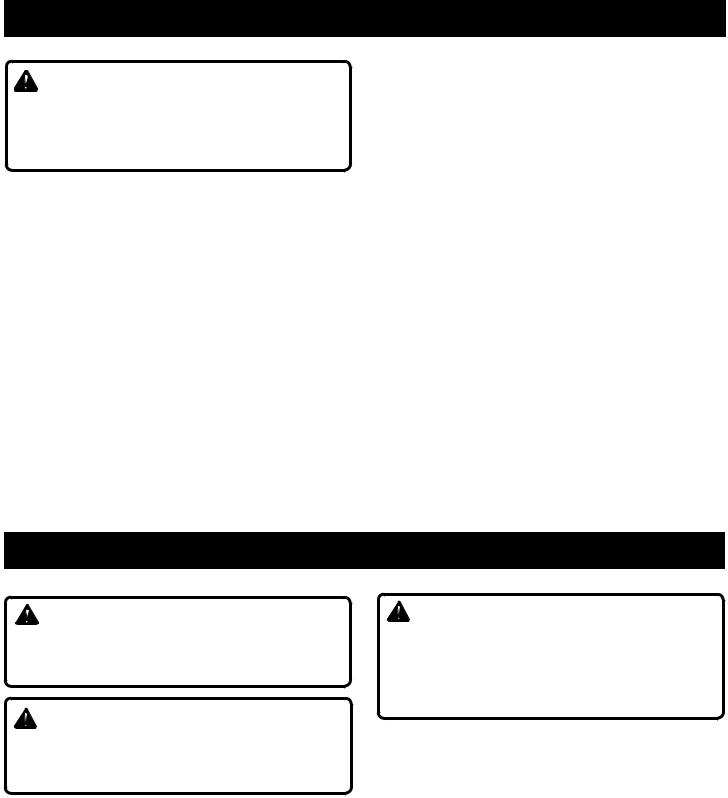
ADJUSTMENTS
WARNING:
Before performing any adjustment, make sure the tool is unplugged from the power supply and the switch is in the OFF position. Failure to heed this warning could result in serious personal injury.
The saw has been adjusted at the factory for making very accurate cuts. However, some of the components might have been jarred out of alignment during shipping. Also, over a period of time, readjustment will probably become necessary due to wear.
Do not start any adjustments until you have checked with a square and made test cuts to be sure adjustments are needed.
To square the cutting wheel to the TABLE
See Figure 27, page 23.
Do not loosen any screws for this adjustment until you have checked with a square and made test cuts to be sure adjustments are necessary. Once the screws are loosened, these items must be reset.
Unplug the saw.
Usinga13mmwrenchoradjustablewrench(notincluded), loosen the hex bolt at the front of the frame and end of the slide rod.
Move the table until the fence is square with the cutting wheel.
Tighten the hex bolt securely.
To ADJUST THE TABLE ROLLERS
See Figure 28, page 23.
If the table doesn’t slide smoothly, seems too loose on the slide rod, or moves side to side, adjustments may be required. There are two different sets of shafts that may require adjustment.
To adjust if the table is loose:
Using a hex key and wrench (not included), loosen the bottom two shafts. These lower shafts can be adjusted up and down on the slide rod.
If the table still doesn’t slide smoothly, loosen the top two shafts.
Oncetherollersare sliding satisfactorily,tightenthe screws securely.
To adjust if the rollers are too tight:
From the side closest to the frame, insert a hex key in the shaft.
Holding the hex key to keep the shaft from turning, loosen the nylock nuts until the table slides at the desired smoothness.
MAINTENANCE
WARNING:
When servicing, use only identical Ryobi replacement parts. Use of any other parts may create a hazard or cause product damage.
WARNING:
Always wear safety goggles or safety glasses with side shields during power tool operation or when blowing dust. If operation is dusty, also wear a dust mask.
GENERAL MAINTENANCE
Avoid using solvents when cleaning plastic parts. Most plastics are susceptible to damage from various types of commercial solvents and may be damaged by their use. Use clean cloths to remove dirt, dust, oil, grease, etc.
WARNING:
Do not at any time let brake fluids, gasoline, petroleumbased products, penetrating oils, etc., come in contact with plastic parts. Chemicals can damage, weaken or destroy plastic which may result in serious personal injury.
LUBRICATION
All of the bearings in this tool are lubricated with a sufficient amount of high grade lubricant for the life of the unit under normal operating conditions. After extended use, lubricate table rollers and clean the slide rod so the table will slide smoothly.
Cleaning the Slide Rod
During use, the slide rod will become dirty preventing the table rollers from sliding smoothly. It is important to clean the slide rod often using a clean, dry cloth.
15 — English

MAINTENANCE
Brush REPLACEMENT
See Figure 29, page 23.
The saw has externally accessible brush assemblies that should be periodically checked for wear.
Proceed as follows when replacement is required:
Unplug the saw.
WARNING:
Failure to unplug the saw could result in accidental starting causing serious injury.
Remove brush cap with a screwdriver. Brush assembly is spring loaded and will pop out when you remove brush cap.
Remove brush assembly.
Check for wear. Replace both brushes when either has less than 1/4 in. length of carbon remaining. Do not replace one side without replacing the other.
Reassemble using new brush assemblies. Make sure curvature of brush matches curvature of motor and that brush moves freely in brush tube.
Make sure brush cap is oriented correctly (straight) and replace.
Tighten brush cap securely. Do not overtighten.
accessories
The following recommended accessories are currently available at retail stores:
080009002119 Water Pump
A18WS07 Stand
 WARNING:
WARNING:
Current attachments and accessories available for use with this tool are listed above. Do not use any attachments or accessories not recommended by the manufacturer of this tool. The use of attachments or accessories not recommended can result in serious personal injury.
NOTE: Figures (illustrations) start on page 17 after French and Spanish language sections.
16 — English

|
TABLE DES MATIÈRES |
Introduction...................................................................................................................................................................... |
2 |
Garantie............................................................................................................................................................................ |
2 |
Règles de sécurité générales........................................................................................................................................ |
3-4 |
Règles de sécurité particulières....................................................................................................................................... |
5 |
Symboles...................................................................................................................................................................... |
6-7 |
Caractéristiques électriques......................................................................................................................................... |
8-9 |
Caractéristiques.......................................................................................................................................................... |
9-10 |
Assemblage............................................................................................................................................................... |
10-12 |
Utilisation.................................................................................................................................................................. |
12-14 |
Réglages........................................................................................................................................................................ |
15 |
Entretien.................................................................................................................................................................... |
15-16 |
Accessoires.................................................................................................................................................................... |
16 |
Figure numéros (illustrations..................................................................................................................................... |
17-20 |
Commande de pièces / réparation................................................................................................................. |
Páge arrière |
|
INTRODUCTION |
Cet outil offre de nombreuses fonctions destinées à rendre son utilisation plaisante et plus satisfaisante. Lors de la conception de ce produit, l’accent a été mis sur la sécurité, les performances et la fiabilité, afin d’en faire un outil facile à utiliser et à entretenir.
GARANTIE
OUTILS ÉLECTRIQUES RYOBI® – GARANTIE LIMITÉE DE DEUX ANS ET POLITIQUE D’ÉCHANGE DE 30 JOURS
One World Technologies, Inc., garantit ses outils électriques dans les conditions suivantes :
POLITIQUE D’ÉCHANGE DE 30 JOURS : En cas de défaillance due à des vices de matériaux ou de fabrication au cours des 30 jours suivant la date d’achat, l’acheteur pourra faire réparer tout outil électrique Ryobi® au titre de cette garantie ou le retourner l’établissement où il a été acheté. Pour obtenir un outil en échange ou demander la réparation en garantie, l’équipement complet devra être retourné, dans son emballage d’origine, accompagné d’une preuve d’achat. L’outil fourni en échange sera couvert par la garantie limitée pour le restant de la période de validité de deux ans à compter de la date d’achat.
CE QUI EST COUVERT PAR LA GARANTIE : Cette garantie couvre tous les vices de matériaux et de fabrication de cet outil électrique Ryobi®, pour une période de deux ans, à compter de la date d’achat. À l’exception des batteries, les accessoires sont garantis pour une période de quatre-vingt-dix (90) jours. Les batteries sont garanties deux ans.
RÉPARATIONS SOUS GARANTIE : Il suffit de retourner l’outil, correctement emballé, en port payé, à un centre de réparations agréé. L’adresse du centre de réparations agréé le plus proche peut être obtenue en contactant un représentant du service après-vente par courrier, à l’adresse One World Technologies, Inc., P.O. Box 1207, Anderson, SC 29622-1207, par téléphone au 1-800-525-2579 ou par courriel, à l’adresse Internet www.ryobitools.com. Lors de toute demande de réparation sous garantie, une preuve d’achat datée (par exemple un reçu de vente) doit être fournie. Nous nous engageons à réparer tous les défauts de fabrication et à réparer ou remplacer, à notre choix, toutes les pièces défectueuses. Les réparations et remplacements seront gratuits. Les réparations sous garantie seront effectuées dans un délai raisonnable, ne dépassant en aucun cas quatre-vingt-dix (90) jours.
CE QUI N’EST PAS COUVERT : La garantie ne couvre que l’acheteur au détail original et n’est pas transférable. Cette garantie ne couvre que les défauts résultant d’une utilisation normale. Elle ne couvre pas les problèmes de fonctionnement, défaillances ou autres défauts résultant d’un usage incorrect ou abusif, de la négligence, de la modification, de l’altération ou de réparations effectuées par quiconque autre qu’un centre de réparations agréé. One World Technologies, Inc. ne fait aucune autre garantie, représentation ou promesse concernant la qualité et les performances de cet outil électrique, autres que celles expressément indiquées dans le présent document.
AUTRES LIMITATIONS : Toutes les garanties implicites accordées par les lois en vigueur, y compris les garanties de valeur marchande ou d’adéquation à un usage particulier, sont limitées à une durée de deux ans, à compter de la date d’achat. One World Technologies, Inc. déclinant toute responsabilité pour les dommages directs ou indirects, les limitations et exclusions peuvent ne pas s’appliquer à chaque acheteur. Cette garantie donne au consommateur des droits spécifiques, et celui-ci peut bénéficier d’autres droits, qui varient selon les états ou provinces.
2 — Français
